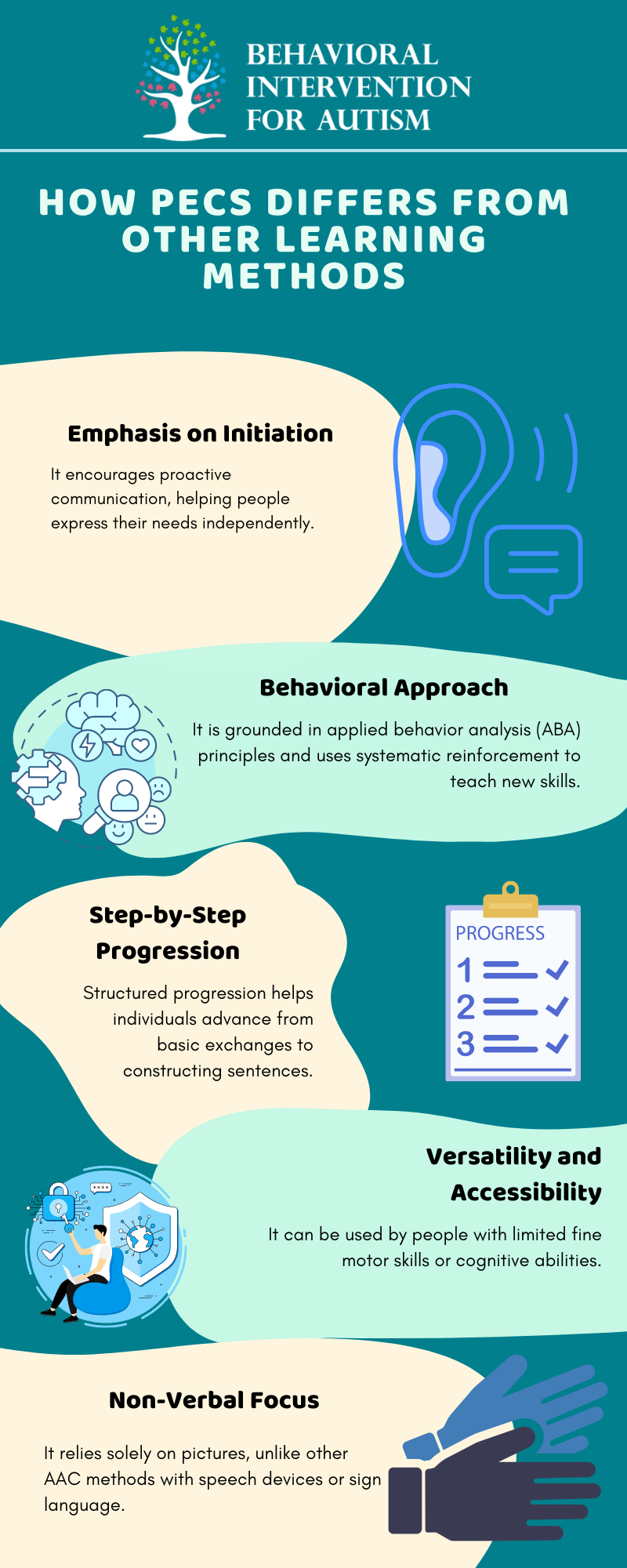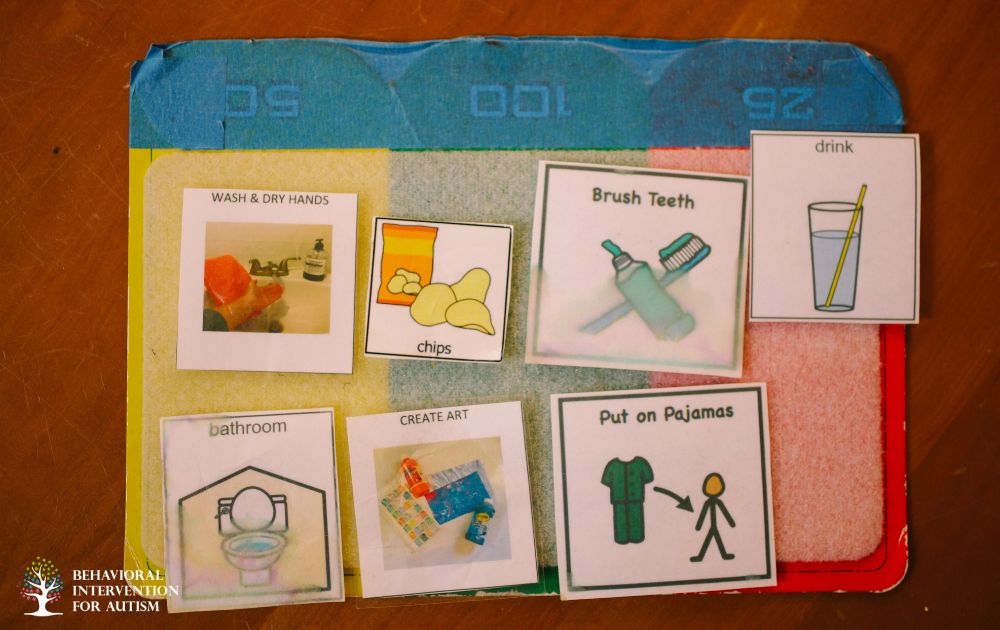
Table of Contents
Picture Exchange Communication Systems, commonly known as PECS, is a form of augmentative and alternative communication (AAC) designed to help individuals with autism and other communication challenges express their needs, desires, and thoughts through the use of pictures. It has been successfully used with many children on the autism spectrum.
Understanding PECS
PECS is a special way for people who find it hard to talk to communicate using pictures. It was made by Andy Bondy and Lori Frost in the late 1980s to help individuals say what they need, want, or feel by showing pictures instead of talking.
PECS was created to be simple to use, not cost a lot of money, and work in different places like homes, schools, and communities. Dr. Bondy and Ms. Frost used their knowledge of behavior analysis and speech-language therapy to make sure PECS was based on good practices.
Controversies Surrounding PECS
Despite being widely used and successful, some people have concerns about PECS. Some experts think that using PECS might make it harder for a person to learn to talk because it focuses on pictures instead of words. They worry that relying on pictures might make someone less interested in learning to speak.
However, others believe that PECS can actually help with learning to talk. They say that using pictures can help someone understand how communication works, which can be a first step toward talking. Another issue is how much training is needed to use PECS properly. Some say that if caregivers don’t get enough training, they might not use PECS the right way.
How PECS Differs from Other Methods
PECS stands out from other AAC systems in several key ways:
- Emphasis on Initiation: Unlike many AAC systems that focus on responding to prompts, PECS emphasizes the importance of the individual initiating communication. This approach encourages proactive communication, helping individuals learn to express their needs independently.
- Behavioral Approach: PECS is grounded in the principles of applied behavior analysis (ABA), which uses systematic reinforcement to teach new skills. This approach ensures that communication behaviors are consistently reinforced, promoting their development and maintenance.
- Step-by-Step Progression: PECS is divided into six phases, each designed to gradually build on the previous skills. This structured progression helps individuals move from basic picture exchanges to constructing sentences, ensuring a clear path of development.
- Versatility and Accessibility: PECS can be used with individuals of all ages and various communication challenges, not just those with autism. Its use of simple picture cards makes it accessible to individuals with limited fine motor skills or cognitive abilities.
- Non-Verbal Focus: While other AAC methods may include high-tech devices with synthesized speech or complex sign language systems, PECS relies solely on pictures. This makes it particularly useful for those who are in the early stages of developing communication skills.
Practical Implementation of PECS
To use PECS well, people learn some steps. First, they pick a picture. Then, they give it to someone else who helps them communicate. Later, they learn to make sentences with the pictures. This helps them get better at talking and doing things on their own.
In PECS, a book or cards with pictures is used. These pictures show different things like objects, actions, or ideas. By trading these pictures, people can talk to others and say what they want. This helps a lot, especially for people with autism or trouble communicating.
The Importance of PECS for Autism
Children with autism often face significant communication challenges. Some may be nonverbal, while others might have limited speech that is difficult to understand. PECS provides these children with a way to communicate their needs and desires, which can reduce frustration, decrease tantrums, and improve social interactions.
Who Can Benefit from PECS?
PECS is suitable for children who:
- Are nonverbal
- Have unintelligible speech
- Are minimally effective communicators
- Have a limited expressive vocabulary
- Show a lack of motivation to communicate
However, PECS may not be necessary for children who are already effective verbal communicators unless their speech primarily consists of echoed repetitions.
Getting Started with PECS
Embarking on the journey with PECS can be both exciting and transformative for individuals with communication challenges. This section will guide you through the initial stages of PECS, from understanding its basic concepts to setting up the necessary materials.
Phase 1: How to Communicate
In the initial phase, children learn to exchange a single picture for a desired item, such as a toy or food.
Phase 2: Distance and Persistence
This phase teaches children to communicate across different settings, with various people, and over distances, enhancing their persistence in making requests.
Phase 3: Picture Discrimination
Children learn to distinguish between two or more pictures to make a request. These pictures are organized in a PECS Communication Book.
Phase 4: Sentence Structure
Using a detachable sentence strip, children construct sentences starting with “I want” followed by a picture of the desired item or activity.
Phase 5: Responsive Requesting
Children learn to answer questions, such as “What do you want?” by using their PECS cards.
Phase 6: Commenting
In the final phase, children are taught to respond to questions and make comments, further developing their communication skills.
Common Challenges and Solutions with PECS
While PECS has proven to be a valuable tool for individuals with communication difficulties, implementing it effectively can sometimes present challenges for caregivers, educators, and therapists. Understanding and addressing these challenges is essential to ensure the success of PECS as a communication method.
Lack of Intentional Communication
If a child has not yet developed intentional communication, it may be helpful to first build a repertoire of gestures and body movements.
Limited Interests
For children with few interests, spending time identifying and expanding their preferences for food, objects, or activities can be beneficial.
Difficulty with Matching Skills
Teaching matching skills as a separate activity can prepare children for more advanced stages of PECS.
Maintaining Progress
Ongoing support and practice are essential. The PECS manual suggests at least 30-40 practice opportunities per day.
Conclusion
PECS has been proven to be a powerful tool for helping children with autism communicate effectively. By following the structured phases and ensuring consistent practice, parents and caregivers can support their child’s communication development, leading to reduced frustration and improved social interactions.
Sources:
- https://www.ncbi.nlm.nih.gov/pmc/articles/PMC3122547/
- https://www.iidc.indiana.edu/irca/articles/successfully-using-pecs.html
- https://pecsusa.com/download/ToPECSornottoPECS.pdf
- 9 Common Obsessions of Children With Autism You Should Know - February 25, 2025
- What is Neurodiversity? A Guide to Embracing Differences - February 25, 2025
- Understanding Hyperfocus in Autism: What It Means and Why It Happens - February 25, 2025



